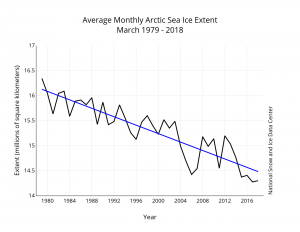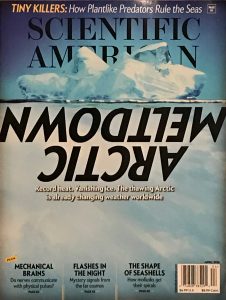Arctic Meltdown – Cover Story SCIENTIFIC AMERICAN
The April cover story of Scientific American is the catastrophe unfolding above the Arctic circle. ARCTIC MELTDOWN, the headline is upside down, presumably to reinforce how the world is turning upside down, metaphorically. The subhead tells the story:
Vanishing Ice. The Thawing Arctic is already changing weather worldwide.

The Arctic is like the canary in the coal mine, with temperatures warming at more than double the global average.
With this article, Jennifer soberly notes that just fifteen years later, there are projections for the Arctic to be ice free in the summer as early as 2040, 60 years ahead of the alarming schedule that she and her colleagues considered at that meeting in ’03.
The effects of an Arctic meltdown are sobering for several reasons:
- Even with the Arctic Ocean being ice-free just in summer, the effect on global weather forces is huge. The open Arctic Ocean changes the “normal” patterns of seasonal air and ocean currents, which changes global weather patterns. Though paradoxical, the effects of the warming planet, and the changing weather patterns includes:
- Longer heat waves
- More wildfires
- Deeper freezes
- Heavier rains –– Of course we are seeing those effects already. The warmer oceans, evaporate more, causing record-breaking precipitation – either rain or snow. Just this week Hawaii had a deluge rain — 50 inches (130 cm) in 24 hours. Two weeks ago, torrential rain in New York City closed sections of the subway system. The world’s weather is connected, with the rapidly thawing Arctic being the key.
- It will almost certainly be many centuries, before that large ocean area could return to the year-round frozen state of the last few million years.
- While melting Arctic sea ice has no effect on global sea level, the melting ice on land–primarily Greenland–will continue to raise global sea level at an increasing pace.
In my recent post from Greenland a few weeks ago “Greenland is Melting and Coming to a City Near You” I wrote that what happens in Greenland does not stay in Greenland. Largely ignored, that gigantic landmass, mostly covered in ice more than a mile deep, will determine how quickly coastlines change all over the world. Also as the Arctic melts, it will affect ALL cities, coastal and inland, as weather patterns worldwide destabilize.
For 172 years Scientific American has been the iconic publication for those in the general public who are keenly interested in science. The Arctic Meltdown happening now is a worthy cover story.
It is incumbent on all of us to spread the word even more widely, both about the need to slow the warming as the highest priority, and to begin adapting to the rising seas and unusual weather that are profound properties of our changing planet.

